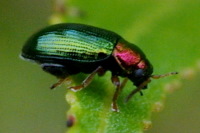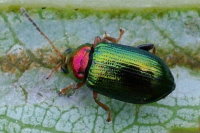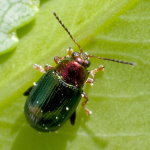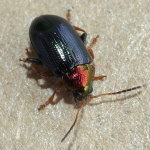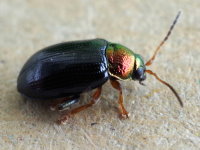Phylum Arthropoda (Arthropods) ➔ Subphylum Hexapoda (Hexapods) ➔ Class Insecta (Insects) ➔ Order Coleoptera (Beetles) ➔ Family Chrysomelidae (Leaf beetles)
Crepidodera aurata (Marsham, 1802)
Weiden-Erdfloh Willow Flea Beetle
Synonyms and other combinations:
Chrysomela aurata Marsham, 1802 | Chalcoides aureola Foudras, 1860 | Haltica pulchella Stephens, 1834 | Haltica versicolor Kutschera, 1860 |
Classification:
Crepidodera aurata belongs to the subfamily Galerucinae, tribe Alticini.Distribution:
PalearcticHabitat:
In both dry and humid habitats, often in river and brook floodplains.Description:
Length 2.5 - 3.5 mm; upper side shiny metallic; pronotum (green to gold or coppery-red to violet) and elytra (blue, green-golden or violet) differently coloured; elytra with completely regular, simple rows of dots, the spaces between which are occupied only by extremely fine, often barely visible dots; pronotum with a distinctly pronounced transverse furrow at the back; dotting of the pronotum strong and very uneven; basal half of the antennae light, gradually darkened towards the tip; front and middle legs monochrome light.Biology:
Crepidodera aurata is a macropterous and airworthy species that forms one generation per year. The imagines can be found on their host plants from May to October (with peaks in late June and mid September). They mostly live on willows [e.g. goat willow (Salix caprea ), almond willow (Salix triandra), crack willow (Salix fragilis), basket willow (Salix viminalis) and white willow (Salix alba)], less frequently on poplars [e.g. aspen (Populus tremula) and black poplar (Populus nigra)].Crepidodera aurata hibernates as imago. After a maturation feeding, the eggs are laid. The larvae develop in summer and live at the roots of willows. The new generation can be found outside from late summer.
References, further reading, links:
- Rheinheimer, Joachim, & Hassler, Michael: Die Blattkäfer Baden-Württembergs, 2018, 928 pages, Kleinsteuber Books (Karlsruhe), ISBN 978-3-9818110-2-5
- Arved Lompe: Die Käfer Europas - Ein Bestimmungswerk im Internet
- Agelastica alni
- Altica sp.
- Aphthona nonstriata
- Bromius obscurus
- Bruchus rufimanus
- Bruchus sp.
- Cassida nebulosa
- Cassida rubiginosa
- Cassida sp.
- Cassida stigmatica
- Cassida vibex
- Cassida vibex/bergeali
- Cassida viridis
- Chrysolina fastuosa
- Chrysolina haemoptera
- Chrysolina hyperici
- Chrysolina lucidicollis
- Chrysolina oricalcia
- Chrysolina sp.
- Chrysolina sturmi
- Chrysolina varians
- Chrysomela populi
- Chrysomela tremula
- Chrysomela vigintipunctata
- Clytra laeviuscula
- Clytra quadripunctata
- Coptocephala sp.
- Crepidodera aurata
- Crepidodera aurea
- Crepidodera fulvicornis
- Crioceris duodecimpunctata
- Cryptocephalinae sp.
- Cryptocephalus moraei
- Cryptocephalus nitidus
- Cryptocephalus pusillus
- Cryptocephalus sp.
- Donacia bicolora
- Donacia cinerea
- Donacia marginata
- Donacia versicolorea
- Galeruca tanaceti
- Galerucella s.l.
- Gastrophysa viridula
- Gonioctena decemnotata
- Gonioctena quinquepunctata
- Gonioctena quinquepunctata/intermedia
- Gonioctena sp.
- Gonioctena viminalis
- Lema cyanella
- Leptinotarsa decemlineata
- Lilioceris lilii
- Lochmaea caprea
- Neocrepidodera ferruginea
- Neocrepidodera sp.
- Oulema melanopus/duftschmidi
- Oulema obscura
- Pachybrachis sp.
- Phratora sp.
- Phratora vitellinae
- Phyllobrotica quadrimaculata
- Phyllotreta armoraciae
- Phyllotreta nemorum
- Phyllotreta vittula
- Plagiodera versicolora
- Plagiosterna aenea
- Plateumaris sp.
- Podagrica fuscicornis
- Psylliodes sp.
- Pyrrhalta viburni
- Sphaeroderma sp.
- Xanthogaleruca luteola
